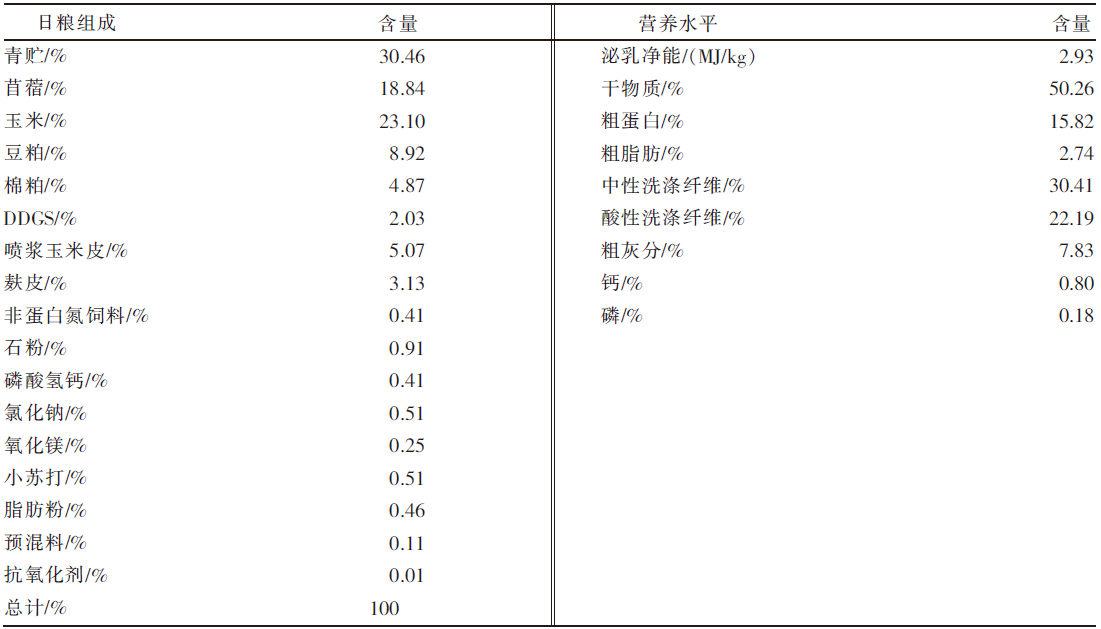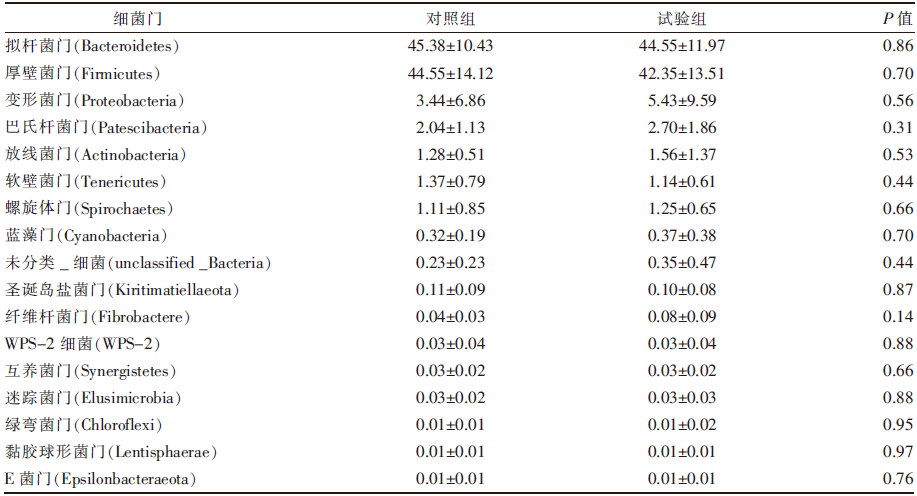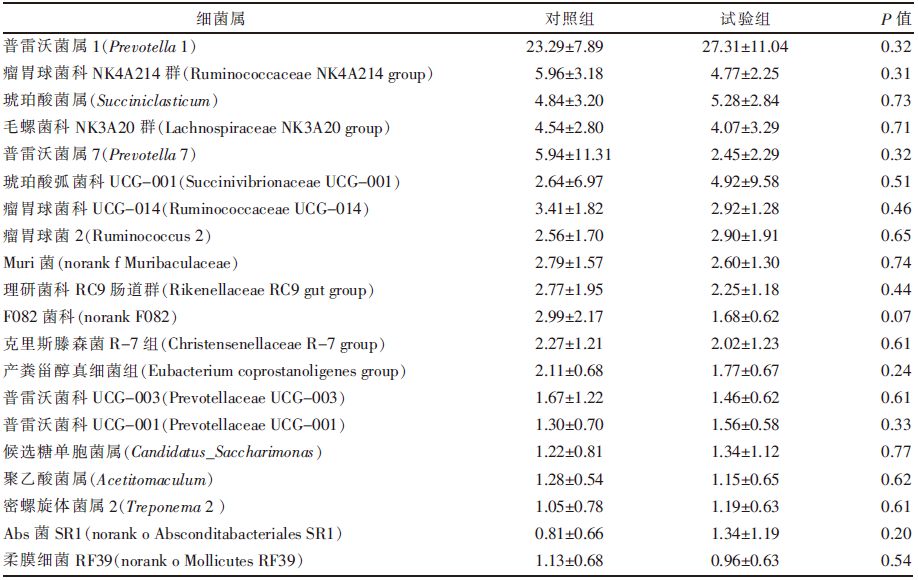Animal Husbandry and Feed Science ›› 2023, Vol. 44 ›› Issue (1): 44-53.doi: 10.12160/j.issn.1672-5190.2023.01.007
• Animal Nutrition and Feed Science • Previous Articles Next Articles
Effects of Compound Plant Extracts on Rumen Bacterial Flora in Dairy Cows
GUO Chen-yang1,2,LIU Jia-lin1,2,ZHANG Teng-long1,2,WANG Li-fang1,2,SONG Jie1,2,ZHONG Hua-chen1,2
- 1. Agricultural Product Quality Safety Risk Assessment Laboratory(Hohhot),Ministry of Agriculture and Rural Affairs,Hohhot 010031,China
2. Inner Mongolia Academy of Agricultural and Animal Husbandry Sciences,Hohhot 010031,China
-
Received:2022-11-04Online:2023-01-30Published:2023-02-14
CLC Number:
Cite this article
GUO Chen-yang, LIU Jia-lin, ZHANG Teng-long, WANG Li-fang, SONG Jie, ZHONG Hua-chen. Effects of Compound Plant Extracts on Rumen Bacterial Flora in Dairy Cows[J]. Animal Husbandry and Feed Science, 2023, 44(1): 44-53.
share this article
| [1] |
JANSSEN P H, KIRS M. Structure of the archaeal community of the rumen[J]. Applied and Environmental Microbiology, 2008, 74(12):3619-3625.
doi: 10.1128/AEM.02812-07 pmid: 18424540 |
| [2] | STEWART C S, FLINT H J, BRYANT M P. The rumen bacteria[M]//HOBSON P N,STEWART C S. The rumen microbial ecosystem. Dordrecht: Springer Netherlands, 1997:10-72. |
| [3] |
DEUSCH S, CAMARINHA-SILVA A, CONRAD J, et al. A structural and functional elucidation of the rumen microbiome influenced by various diets and microenvironments[J]. Frontiers in Microbiology, 2017, 8:1605.
doi: 10.3389/fmicb.2017.01605 pmid: 28883813 |
| [4] | 洪义国, 孙谧, 张云波, 等. 16S rRNA在海洋微生物系统分子分类鉴定及分子检测中的应用[J]. 海洋水产研究, 2002, 23(1):58-63. |
| [5] | 刘朝军, 沈定霞. 16S rDNA序列测定在细菌鉴定中的应用[J]. 军医进修学院学报, 2011(7):774-776. |
| [6] |
LIN B, LU Y, WANG J, et al. The effects of combined essential oils along with fumarate on rumen fermentation and methane production in vitro[J]. Journal of Animal and Feed Sciences, 2012, 21(1):198-210.
doi: 10.22358/jafs/66064/2012 |
| [7] |
KLEVENHUSEN F, MURO-REYES A, KHIAOSA-ARD R, et al. A meta-analysis of effects of chemical composition of incubated diet and bioactive compounds on in vitro ruminal fermentation[J]. Animal Feed Science and Technology, 2012, 176(1/2/3/4):61-69.
doi: 10.1016/j.anifeedsci.2012.07.008 |
| [8] |
潘龙, 卜登攀, 王加启, 等. 柴胡中草药对奶牛瘤胃菌群多样性及纤维分解菌的影响[J]. 草业学报, 2015, 24(3):219-225.
doi: 10.11686/cyxb20150323 |
| [9] |
占今舜, 邬彩霞, 刘明美, 等. 饲粮添加苜蓿黄酮对奶牛瘤胃菌群的影响[J]. 草业学报, 2017, 26(7):82-89.
doi: 10.11686/cyxb2016358 |
| [10] |
HU W L, LIU J X, YE J N, et al. Effect of tea saponin on rumen fermentation in vitro[J]. Animal Feed Science and Technology, 2005, 120(3/4):333-339.
doi: 10.1016/j.anifeedsci.2005.02.029 |
| [11] | 卢德勋. 营养活性物质组学产品研发和应用的理论和实践[J]. 饲料工业, 2018, 39(1):2-6. |
| [12] |
陈祥宇, 耿浩川, 侯建库, 等. 复合植物提取物对蛋鸡生产性能、肠道黏膜形态及盲肠菌群结构的影响[J]. 动物营养学报, 2021, 33(4):2033-2043.
doi: 10.3969/j.issn.1006-267x.2021.04.023 |
| [13] |
郭晨阳, 张腾龙, 徐腾腾, 等. 复合植物提取物对荷斯坦奶牛体外瘤胃发酵的影响[J]. 动物营养学报, 2020, 32(8):3698-3707.
doi: 10.3969/j.issn.1006-267x.2020.08.028 |
| [14] |
徐腾腾, 张腾龙, 王丽芳, 等. 复合植物提取物对奶牛生产性能及血清免疫、抗氧化指标的影响[J]. 动物营养学报, 2019, 31(12):5707-5718.
doi: 10.3969/j.issn.1006-267x.2019.12.037 |
| [15] | 王加启. 现代奶牛养殖科学[M]. 北京: 中国农业出版社, 2006. |
| [16] | 刘琳. 丙酮酸肌酸在缓解热应激肉牛瘤胃功能上的作用及机制研究[D]. 南昌: 江西农业大学, 2020. |
| [17] | 王莹. 基于肠道微环境探讨金银花与山银花多糖的免疫调节作用差异[D]. 北京: 北京中医药大学, 2020. |
| [18] | 李倩. 果胶低聚糖调节肠道菌群及改善小鼠肥胖症状和炎症的研究[D]. 郑州: 郑州大学, 2021. |
| [19] | 赵丽君, 田雪, 钟威, 等. 基于高通量测序技术分析预包装豆干生产过程中的真菌污染风险[J]. 食品工业科技, 2021, 42(9):207-213. |
| [20] | 董志祥. 东、西方蜜蜂肠道菌群定植规律研究[D]. 昆明: 昆明理工大学, 2020. |
| [21] | 祁茹, 林英庭, 程明, 等. 瘤胃微生物区系及其相互关系的研究进展[J]. 饲料博览, 2011(8):9-13. |
| [22] | 周国娜, 袁胜亮, 崔书文. 不同林分林下植被的多样性特征及生物量研究[J]. 湖北农业科学, 2012, 51(18):4052-4056. |
| [23] | 沙蒙. 苯氧威对掌肢新米虾Neocaridina palmata种群及相关群落的影响[D]. 杭州: 浙江大学, 2021. |
| [24] | 许晴, 张放, 许中旗, 等. Simpson指数和Shannon-Wiener指数若干特征的分析及“稀释效应”[J]. 草业科学, 2011, 28(4):527-531. |
| [25] |
SIMPSON E H. Measurement of diversity[J]. Nature, 1949, 163(4148):688.
doi: 10.1038/163688a0 |
| [26] |
CAUSEY B D. Parametric estimation of the number of classes in a population[J]. Journal of Applied Statistics, 2002, 29(6): 925-934.
doi: 10.1080/02664760220136221 |
| [27] |
MAO S Y, ZHANG R Y, WANG D S, et al. The diversity of the fecal bacterial community and its relationship with the concentration of volatile fatty acids in the feces during subacute rumen acidosis in dairy cows[J]. BMC Veterinary Research, 2012, 8:237.
doi: 10.1186/1746-6148-8-237 pmid: 23217205 |
| [28] |
SEGATA N, IZARD J, WALDRON L, et al. Metagenomic biomarker discovery and explanation[J]. Genome Biology, 2011, 12(6):R60.
doi: 10.1186/gb-2011-12-6-r60 |
| [29] | 付琦, 侯先志, 高爱武. 瘤胃微生物区系及相互关系的研究进展[J]. 中国奶牛, 2009(5):18-21. |
| [30] | 谭翠, 王之盛, 王立志, 等. 肉牛剩余采食量与瘤胃微生物菌群关系[J]. 动物营养学报, 2015, 27(10):2987-2993. |
| [31] | 徐俊. 不同牧草来源的NDF在瘤胃中降解特性及其对细菌群落结构的影响[D]. 扬州: 扬州大学, 2014. |
| [32] |
MCCANN J C, WILEY L M, et al. Relationship between the rumen microbiome and residual feed intake-efficiency of Brahman bulls stocked on bermudagrass pastures[J]. PLoS One, 2014, 9(3):e91864.
doi: 10.1371/journal.pone.0091864 |
| [33] |
MATSUI H, OGATA K, TAJIMA K, et al. Phenotypic characterization of polysaccharidases produced by four Prevotella type strains[J]. Current Microbiology, 2000, 41(1):45-49.
doi: 10.1007/s002840010089 |
| [34] |
TAJIMA K, ARAI S, OGATA K, et al. Rumen bacterial community transition during adaptation to high-grain diet[J]. Anaerobe, 2000, 6(5):273-284.
doi: 10.1006/anae.2000.0353 |
| [35] | 吴琼, 王思珍, 张适, 等. 基于16S rRNA高通量测序技术分析安格斯牛瘤胃微生物多样性和功能预测的研究[J]. 微生物学杂志, 2020, 40(2):49-56. |
| [36] |
DE OLIVEIRA M N V, JEWELL K A, FREITAS F S, et al. Characterizing the microbiota across the gastrointestinal tract of a Brazilian Nelore steer[J]. Veterinary Microbiology, 2013, 164(3/4):307-314.
doi: 10.1016/j.vetmic.2013.02.013 |
| [37] |
EDWARDS J E, MCEWAN N R, TRAVIS A J, et al. 16S rDNA library-based analysis of ruminal bacterial diversity[J]. Antonie Van Leeuwenhoek, 2004, 86(3):263-281.
pmid: 15539930 |
| [38] |
QIN J J, LI R Q, RAES J, et al. A human gut microbial gene catalogue established by metagenomic sequencing[J]. Nature, 2010, 464(7285):59-65.
doi: 10.1038/nature08821 |
| [39] | 丁赫, 刘旺景, 敖长金, 等. 饲粮中添加沙葱粉或复合益生菌制剂对杜寒杂交羊瘤胃发酵参数和瘤胃液菌群多样性的影响[J]. 动物营养学报, 2019, 31(1):324-333. |
| [40] |
FERNÁNDEZ-GÓMEZ B, RICHTER M, SCHÜLER M, et al. Ecology of marine Bacteroidetes: A comparative genomics approach[J]. The ISME Journal, 2013, 7(5):1026-1037.
doi: 10.1038/ismej.2012.169 |
| [41] | 苏婷婷, 韩迪, 张璐, 等. 单宁对反刍动物氮代谢及瘤胃微生物影响的研究进展[J]. 中国畜牧杂志, 2022, 58(4):21-25. |
| Viewed | ||||||
|
Full text |
|
|||||
|
Abstract |
|
|||||















